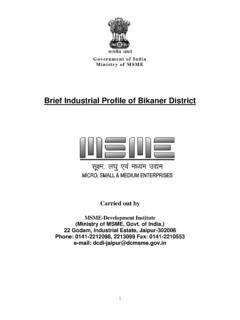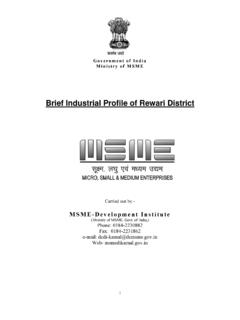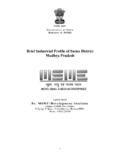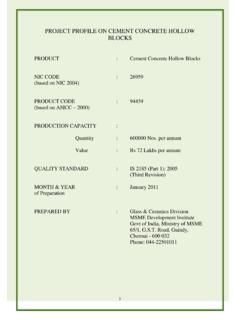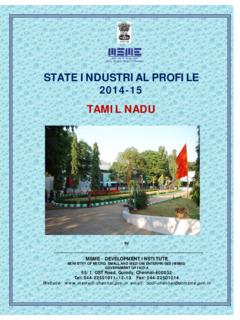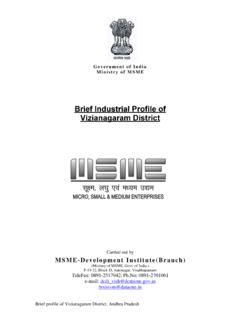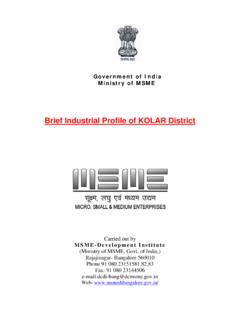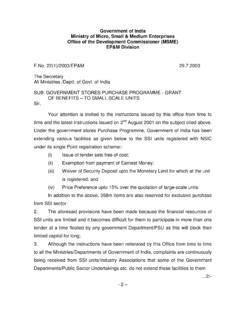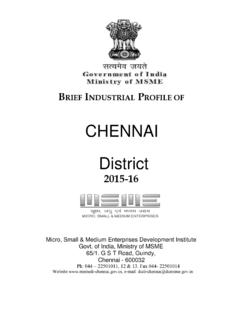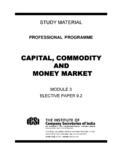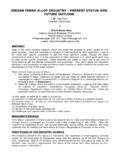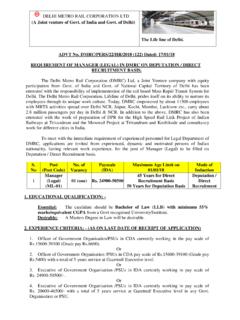Transcription of INDUSTRIAL PROFILE OF Madhya Pradesh 2014-15
1 Page 1 G o v e r n m e n t o f I n d i a M i n i s t r y o f M S M E INDUSTRIAL PROFILE OF Madhya Pradesh 2 0 1 4-15 Carried out by M S M E-D e v e l o p m e n t I n s t i t u t e , I n d o r e (Ministry of MSME, Govt. of India,) Phone 0731-2421037, 1659 Fax: 0731-2420723 e-mail: Web- Page 2 Contents S. No. Topic Page No. 1 General Characteristics of the State 3 2 Location & Geographical Area 3 3 Topography 4 4 Economy & Infrastructure 4-5 5 Availability of Minerals 5-7 6 Forest 8 7 Agriculture resources & Production 9 8 Administrative set up 10-11 9 Health Institute in Madhya Pradesh 11 10 INDUSTRIAL scenario in Madhya Pradesh 12-13 11 MSME scenario in Madhya Pradesh 14 12 NIC wise scenario of MSME in Madhya Pradesh 2012-13 & 2013-14 14-16 13 INDUSTRIAL Areas in Madhya Pradesh managed by DTICs 17-18 14 Developed land available for allotment by AKVN 19-20 15 Cluster 21-22 16 Large scale Industries in Madhya Pradesh 23-31 17 Medium scale Industries in Madhya Pradesh 31-38 18 Opportunities in investment in different Sectors 39-49 19 Up Coming Project 50-56 Page 3 1.
2 General Characteristics of the State Madhya Pradesh had the honor of being the largest state of the country until Chhattisgarh was carved out of it on 1st November 2000. Landlocked in the central part of the country, Madhya Pradesh is bordered by the states of Rajasthan to the northwest, Uttar Pradesh to the north, Chhattisgarh to the east, Maharashtra to the south, and Gujarat to the west. The history of Madhya Pradesh goes back to the time of Ashoka, the great Maury an ruler. A major portion of Central India was part of the Gupta Empire (300-550 AD). In the first half of the seventh century the state was part of the domains of the famous emperor Harsha. The close of tenth century was a period of confusion. In the early eleventh century the Muslims entered central India, first Mahmud of Ghazni and then Mohammad Gori who incorporated certain parts with Sultanate of Delhi.
3 It also formed part of the Mughal Empire with the rise of Maratha's. Till the death of Madhoji Scindia in 1794, Marathas ruled supreme in Central India, but after that independent and smaller states came into being. The disintegrated smaller states paved way for British sovereignty. Some great women rulers of the region like Rani Ahilyabai Holkar of Indore, Gond queen Rani Kamla Devi and Rani Durgawati have carved a niche for themselves in history. When India became independent in 1947, the British Indian province of Central Provinces and Berar formed Madhya Pradesh . Boundary changes followed and finally the state of Chhattisgarh was carved out of Madhya Pradesh . 2. Location & Geographical Area. Nicknamed the "heart of India" due to its geographical location in India, Madhya Pradesh is the second largest state in the country by area.
4 With over 75 million inhabitants, it is the sixth largest state in India by population. The area covered by the present-day Madhya Pradesh includes the area of the ancient Avanti mahajanapada, whose capital Ujjain (also known as Avanti) arose as a major city during the second wave of Indian urbanization in the sixth century BCE. Subsequently, the region was ruled by the major dynasties of India, including the Mauryans, the Mughals and the Marathas. By the early 18th century, the region was divided into several small kingdoms which were captured by the British and incorporated in to Central Provinces and Berar and the Central India Agency. After India's independence, Madhya Pradesh state was created with Nagpur as its capital: this state included the southern parts of the present-day Madhya Pradesh and Maharashtra.
5 In 1956, this state was reorganized and its parts were combined with the states of Madhya Bharat,Vindhya Pradesh and Bhopal to form the new Madhya Pradesh state with Bhopal as its capital. This state was the largest state of India by area until 2000. In 2000, the Chhattisgarh region was split to create a new state, and Rajasthan became the largest state of Pradesh is home to a large tribal population, which has been largely cut-off from the mainstream development. This makes MP one of the least developed states in India, with an HDI value of (2011), which is below the national average. The state's per- Page 4 capita gross state domestic product (nominal GDP) is the fourth lowest in the country (2010 11) MP is also the lowest-ranked state on the India State Hunger Index.
6 3. Topography: Madhya Pradesh has a mixed topography that consists of both hills and plains. The state has three predominant seasons: winter (November through February), summer (March through May), and the monsoon season (June through September). During the winter average temperatures range from 10 to 27 C (50 to 81 F). Summers are hot, with an average temperature of 29 C (85 F) and a high temperature that at times reaches 48 C (118 F). During the monsoon season temperatures average 19 to 30 C (66 to 86 ). Madhya Pradesh receives an average annual rainfall of about 1200 mm (nearly 50 in), of which 90 percent falls during the monsoon season. Date of Formation Nov 1, 1956 Size 3,08,000 sq km Population 7,25,97,565 (Census 2011) Capital Bhopal Rivers Narmada, Tapti, Betwa, Son, & Chambal Forests National Park Bandhavgarh NP, Kanha NP, Pench NP, Indrawati Tigar Reserve, Kheoni WS Languages Hindi Neighbors State Maharashtra, Gujarat, Rajasthan, Uttar Pradesh , Chhattisgarh State Animal Swamp Deer State Bird Paradise Fly-catcher 4.
7 Economy & Infrastructure: Agriculture is the basis of Madhya Pradesh economy. Less than half of the land area is cultivable; however its distribution is quite uneven because of variations in topography, rainfall, and soils. The main cultivated areas are found in the Chambal valley, the Malwa Plateau, the Rewa Plateau, and the Chhattisgarh Plain. The Narmada valley, covered with river-borne alluvium, is another fertile area. The most important crops are rice, wheat, sorghum (jowar), corn (maize), pulses (legumes such as peas, beans, or lentils), and peanuts (groundnuts). Rice is grown principally in the east, where there is more rainfall, while in western Madhya Pradesh wheat and sorghum are more important. The state is the largest soybean producer in India.
8 Other crops include linseed, sesame, sugarcane, and cotton, as well as inferior millets, which are grown in hilly areas. The state is a large producer of opium (in the western district of Mandasor, near Rajasthan) and marijuana (in the southwestern district of Khandwa [East Nimar]). Page 5 Road Transport: Madhya Pradesh has total road length of 91968 km 16 national highways passing through the state Total length of 4670 Km MP has the 3rd largest National Highway Network in the country Length of State Highways 10249 km Rail Transport: Well connected with the rest of India with almost 425 trains passing through the State on a daily basis Of these 175 trains pass through the State capital Bhopal alone Itarsi railway station strategically located in the centre of country Air Transport.
9 25 airstrips available for operationalization Convenient air links from key Indian cities like Delhi & Mumbai to Bhopal, Jabalpur, Gwalior, Indore and Khajuraho 5 operational airports Indore airport has the capability of handling international cargo International airports proposed in Bhopal and Indore Page 6 5. Availability of Minerals. Madhya Pradesh is rich in minerals, though these resources have not yet been fully exploited. There are large reserves of coal and important deposits of iron ore, manganese ore, bauxite, limestone, dolomite, copper, fireclay, and china clay. Diamond reserves at Panna are of particular interest. Production of Mineral 2011-12: Major Minerals Name of the Minerals Production 2011-12 1 Coal 71658 (Thousand Tonnes) 2 Lime Stone 32658 (Thousand Tonnes) 3 Copper 2082 (Thousand Tonnes) 4 Manganese 648 (Thousand Tonnes) 5 Diamonds (In Karate) 18489 6 Dolomite 361 (Thousand Tonnes) 7 Boxcide 617 (Thousand Tonnes) 8 Rock Phosphate 244 (Thousand Tonnes) 9 phyrophilite 209421 (Tonnes) 10 Fire Clay 64158 (Tonnes) 11 Lateritic 166 (Thousand Tonnes) 12 Iron ore 1102 (Thousand Tonnes) 13 Shale 543 (Thousand Tonnes) 14 Kaolin 6950 (Tonnes) 15 Clay 421 (Thousand Tonnes) 16 Occur 35060 (Tonnes) 17 Quartz NA 18 Diaspora 12399 (Tonnes) Page 7 Minor Minerals: Name of the minor minerals Production (in Cub.)
10 Meter) 2011-12 1 Flag Stone 580427 2 Stone/ Gitti 11989031 3 Dhoka Stone 4792483 4 Murum 12687100 5 Clay 383096 6 Marble 157064 7 Granite 36428 8 Sand 19424543 9 Fullers earth 10200 10 Lime stone 14119 (in tonne) Source:- Dept. Of Mines & Geology., Mineral Based industries in MP Sr. no. Industries No. of units Location 1 Cement 09 Rewa, Satna, Damoh, Katni, Sidji & Neemuch. 2 Thermal Power 10 Shahdol, Umariya, Sidhi, satna, Betul, Damoh, Katni, Rewa, Ujjain. 3 Coal Ossuary 03 Narsinghpur, Annuppur, Chindwara. 4 Asbestos Cement Sheet 01 Katni 5 Ceramic 02 Ratlam, Jabalpur 6 Hydrated Lime 25 Katni, Satna 7 Slate Pencil 155 Mandsour 8 Clay product 02 Ujjain Page 8 9 Refectories 03 Katni, Ratlam, Jabalpur 10 Roofing Tiles 08 Hoshangabad, Balaghat. 11 Marble cutting, Polishing 04 Katni 12 Granite cutting, polishing 05 Chattarpur, Tikamgarh 13 Flag Stone Cutting, polishing 150 Shivpuri, Gwalior, Panna, Vidisha.
